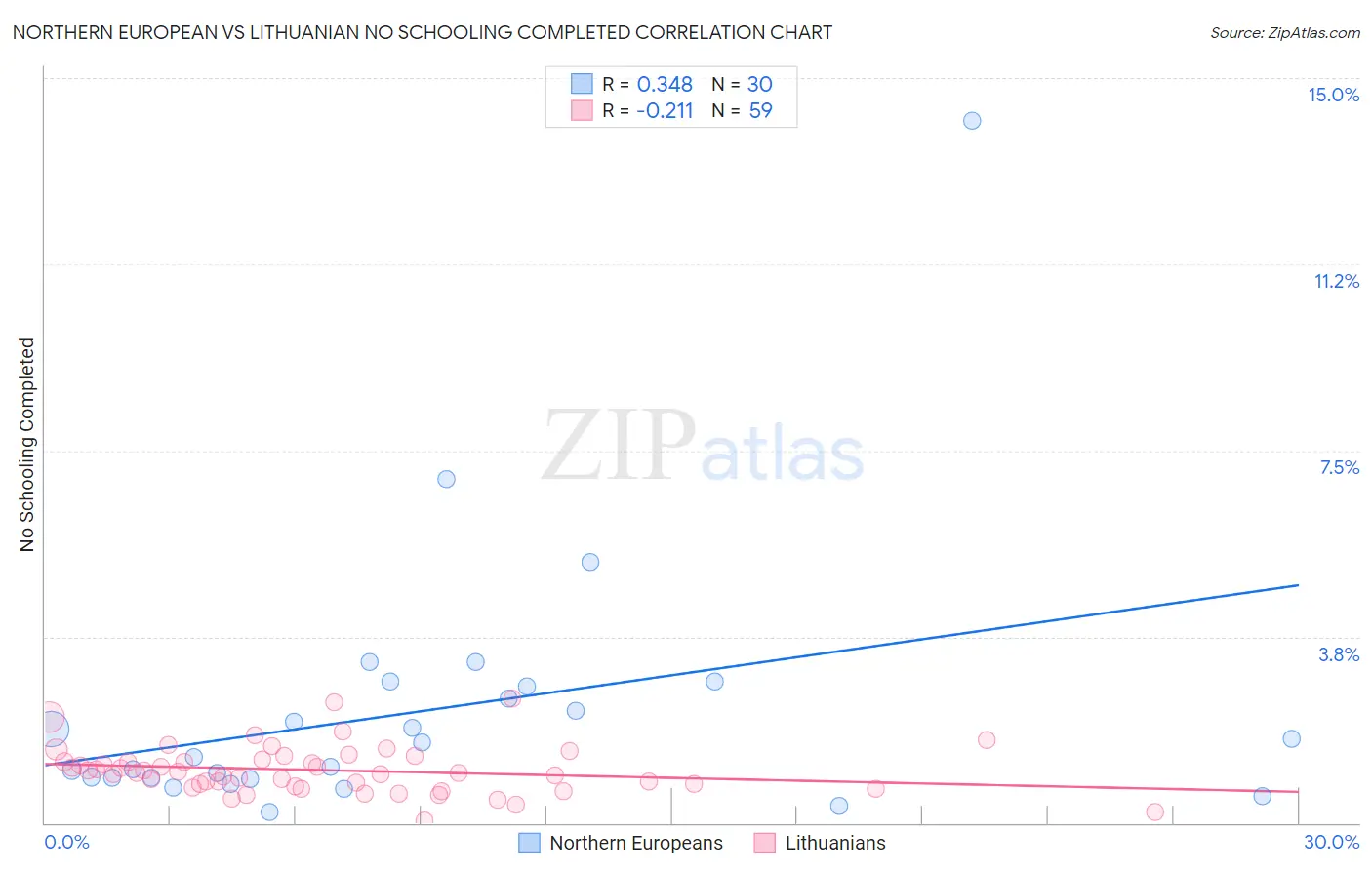Northern European vs Lithuanian No Schooling Completed
COMPARE
Northern European
Lithuanian
No Schooling Completed
No Schooling Completed Comparison
Northern Europeans
Lithuanians
1.6%
NO SCHOOLING COMPLETED
99.9/ 100
METRIC RATING
38th/ 347
METRIC RANK
1.4%
NO SCHOOLING COMPLETED
100.0/ 100
METRIC RATING
11th/ 347
METRIC RANK
Northern European vs Lithuanian No Schooling Completed Correlation Chart
The statistical analysis conducted on geographies consisting of 399,870,964 people shows a mild positive correlation between the proportion of Northern Europeans and percentage of population with no schooling in the United States with a correlation coefficient (R) of 0.348 and weighted average of 1.6%. Similarly, the statistical analysis conducted on geographies consisting of 415,193,435 people shows a weak negative correlation between the proportion of Lithuanians and percentage of population with no schooling in the United States with a correlation coefficient (R) of -0.211 and weighted average of 1.4%, a difference of 9.9%.

No Schooling Completed Correlation Summary
| Measurement | Northern European | Lithuanian |
| Minimum | 0.21% | 0.047% |
| Maximum | 14.1% | 2.5% |
| Range | 13.9% | 2.5% |
| Mean | 2.3% | 1.1% |
| Median | 1.5% | 1.0% |
| Interquartile 25% (IQ1) | 0.90% | 0.74% |
| Interquartile 75% (IQ3) | 2.8% | 1.3% |
| Interquartile Range (IQR) | 1.8% | 0.55% |
| Standard Deviation (Sample) | 2.7% | 0.48% |
| Standard Deviation (Population) | 2.6% | 0.47% |
Similar Demographics by No Schooling Completed
Demographics Similar to Northern Europeans by No Schooling Completed
In terms of no schooling completed, the demographic groups most similar to Northern Europeans are Belgian (1.6%, a difference of 0.13%), Native Hawaiian (1.6%, a difference of 0.27%), Aleut (1.6%, a difference of 0.40%), Luxembourger (1.6%, a difference of 0.61%), and Hungarian (1.6%, a difference of 0.89%).
| Demographics | Rating | Rank | No Schooling Completed |
| Inupiat | 100.0 /100 | #31 | Exceptional 1.5% |
| Swiss | 100.0 /100 | #32 | Exceptional 1.5% |
| Italians | 100.0 /100 | #33 | Exceptional 1.5% |
| Latvians | 100.0 /100 | #34 | Exceptional 1.5% |
| Eastern Europeans | 100.0 /100 | #35 | Exceptional 1.6% |
| Aleuts | 99.9 /100 | #36 | Exceptional 1.6% |
| Belgians | 99.9 /100 | #37 | Exceptional 1.6% |
| Northern Europeans | 99.9 /100 | #38 | Exceptional 1.6% |
| Native Hawaiians | 99.9 /100 | #39 | Exceptional 1.6% |
| Luxembourgers | 99.9 /100 | #40 | Exceptional 1.6% |
| Hungarians | 99.9 /100 | #41 | Exceptional 1.6% |
| Bulgarians | 99.9 /100 | #42 | Exceptional 1.6% |
| Australians | 99.9 /100 | #43 | Exceptional 1.6% |
| Estonians | 99.9 /100 | #44 | Exceptional 1.6% |
| Czechoslovakians | 99.9 /100 | #45 | Exceptional 1.6% |
Demographics Similar to Lithuanians by No Schooling Completed
In terms of no schooling completed, the demographic groups most similar to Lithuanians are Irish (1.4%, a difference of 0.030%), Polish (1.4%, a difference of 0.050%), Dutch (1.4%, a difference of 0.84%), Scotch-Irish (1.5%, a difference of 1.0%), and Tlingit-Haida (1.5%, a difference of 1.1%).
| Demographics | Rating | Rank | No Schooling Completed |
| Germans | 100.0 /100 | #4 | Exceptional 1.4% |
| Slovenes | 100.0 /100 | #5 | Exceptional 1.4% |
| Carpatho Rusyns | 100.0 /100 | #6 | Exceptional 1.4% |
| English | 100.0 /100 | #7 | Exceptional 1.4% |
| Swedes | 100.0 /100 | #8 | Exceptional 1.4% |
| Scottish | 100.0 /100 | #9 | Exceptional 1.4% |
| Dutch | 100.0 /100 | #10 | Exceptional 1.4% |
| Lithuanians | 100.0 /100 | #11 | Exceptional 1.4% |
| Irish | 100.0 /100 | #12 | Exceptional 1.4% |
| Poles | 100.0 /100 | #13 | Exceptional 1.4% |
| Scotch-Irish | 100.0 /100 | #14 | Exceptional 1.5% |
| Tlingit-Haida | 100.0 /100 | #15 | Exceptional 1.5% |
| Finns | 100.0 /100 | #16 | Exceptional 1.5% |
| Croatians | 100.0 /100 | #17 | Exceptional 1.5% |
| Danes | 100.0 /100 | #18 | Exceptional 1.5% |